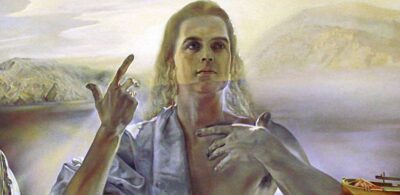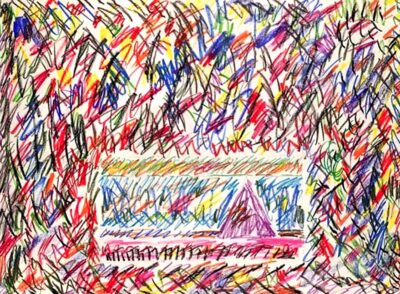Hunter Biden’s very first art exhibit.
When speaking of banality in twenty-first century art, many names come to mind, but now there is a new dim star flaming out across the murky and corrupted skies of contempo art heaven. That not so bright heavenly body is named Hunter Biden.
On Oct 1, 2021, 51-year-old Hunter Biden held his very first art exhibit. The show was arranged by Georges Bergès, the New York gallerist representing Hunter. The invitation-only exhibit took place at Milk Studios in Hollywood, California, and continues until November.

Roughly 200 gawkers, glitterati and gullible buyers attended the opening. With sushi hors d’oeuvres and champaign, it was your typical ritzy Los Angeles art world soirée—but with a twist, a secret service man was in every corner!
A handful of celebrities showed up at the exhibit, goodness knows why. The gallery required proof of vaccination for entry, and Los Angeles Mayor Eric Garcetti wandered around in a Covid mask to set the proper mood for the paparazzi—though most attendees did not wear masks. Garcetti was of course the former national co-chair of Joe Biden’s 2020 campaign.
A handful of art world “luminaries” also attended; Millie Brown the “performance artist” waltzed in. She is lauded by postmodern sophisticates as the newest YBA (that’s “Young British Artist” to you unchic yobs). Millie has literally made a splash on the art scene; she drinks soy milk mixed with food dye, sticks her finger down her throat, and vomits up the mess onto canvas. No, I am not kidding.
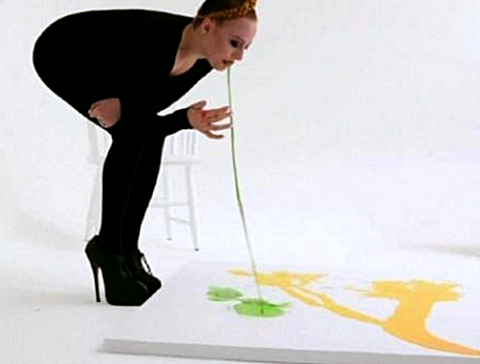
Of course, Millie tossing her cookies is highly derivative of YBA Martin Creed and his 2006 era vomit video performances like Work No. 610, but plagiarism is a crown worn with pride by postmodern artists.
One can see similarities between Millie’s “vomit paintings” and Hunter’s vomitous watercolors. While Hunter’s paintings are astronomically priced, you can still pick up a pleasant little Millie barf canvas for under $3,000. However, don’t wait too long, Millie disgorges works at a nauseating pace and aficionados line up to spew cash in her direction.
For his watercolors Hunter Biden “paints” alcohol inks onto Japanese Yupo paper, a synthetic nonporous paper made of thermoplastic polymer that alcohol inks bond to. To apply the ink he uses traditional watercolor brushes and sometimes a wok brush—the bamboo kitchen tool used to clean the rounded bottom steel cooking pans of China. Hunter knows a few things about China, but that is another story.
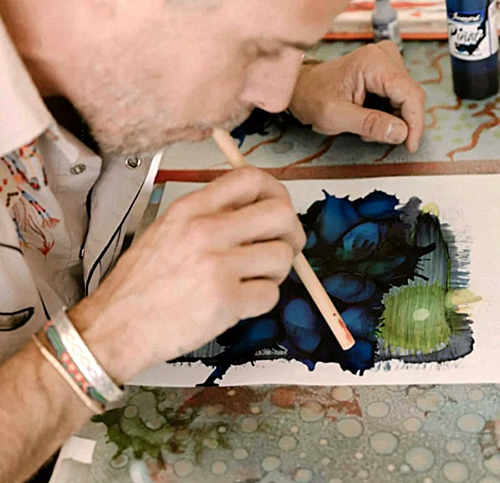
An ordinary straw is the preferred tool Hunter uses to manipulate the inks in his paintings. Over the years he has acquired great skill in the use of a straw. His challenge today as an artist is to resist the habit of sniffing through the straw, and instead blowing through the straw with his lips to push colorful alcohol inks around on paper.
Amusingly, when you type “alcohol inks” into a search engine’s image bank, you will find artworks that look remarkably like Hunter’s ink painting “masterworks.” It’s just that no one is brazen enough to ask $500,000 for one.
The problem with Hunter’s first exhibit are the prices of his original works, they start at $75,000 they go up to half a million. Those are unheard of prices for an unknown artist who never sold an art piece or had an exhibition, not just unlikely prices but impossible ones. However, since the single entry in Hunter’s catalogue of artistic achievements is listed as “Son of the President,” there is good reason to suspect something else besides art is being offered for purchase.
Hunter made his first sale of art at his very first exhibit when five of his art prints were sold by the Georges Bergès Gallery in LA, just prior to opening its Milk Studios showing. The prints were purchased by an anonymous buyer at $75,000 each, for a total of $375,000. It is not known if the prints were reproductions of Hunter’s original works, or if the prints were a signed and numbered edition. At any rate, it is an enormous sum for an emerging artist. By comparison signed prints by Pop Art icon Ed Ruscha can go for as little as $2,500, and he is a legend of the 20th century California art scene.
Think about this for a moment. Recently a small painting by Pablo Picasso was found in a closet where it had been stored for 50 years. On June 26, 2021, the painting was sold at auction for $150,000. In the same timeframe we are told that five Hunter Biden prints are worth $375,000. Is this a joke, Hunter’s art worth more than Pablo Picasso’s? There is not a shred of sanity left in the art world, nor in the sycophantic press that goes along with this nonsense.
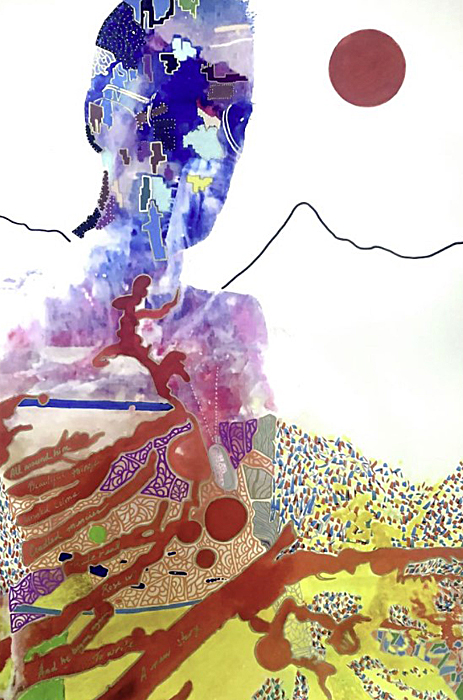
Many voices both in and out of the art world expressed concerns that Hunter’s high priced artworks were part of a pay-for-play scheme; meaning, spend $500,000 on a painting by Hunter and you get a meeting with Lunchbox Joe from Scranton! Alarmed, the Biden White House and gallery owner Georges Bergès crafted a plan to keep the identities of buyers secret from the press, Hunter, the president, and society at large. Only Bergès will know the identities of buyers, that way—wink wink nudge nudge, “ethical issues” will be avoided.
But there is a giant hole in the White House/Bergès pact to keep the names of buyers from Hunter. The “artist” attended the show’s opening and rubbed elbows with potential purchasers; he conversed with them, posed for photos with them, and drank champaign with them. Ever been to a large art opening? What do you suppose Hunter discussed with his audience?
Richard Painter was the former chief White House ethics lawyer that served under the George W. Bush administration from 2005 to 2007. Yeah I know, Dubya had an ethics lawyer? Keep laughing, but when you stop to catch your breath, Painter said Hunter showing up at his own exhibit “illustrates how this veil of secrecy idea is not happening. It shows the deal is not going to be secret. I think the White House needs to go to Plan B.” Painter went on to say: “Buyers tend to be rich people, and rich people come to their houses and it tends to get around. Everyone’s going to be talking about it and everyone’s going to know.”
OK, so you are a liberal that thinks an establishment Republican like Mr. Painter has no credibility. Well, that is correct, so here is the opinion of an establishment Democrat that has no credibility, Walter Shaub. He was the Obama White House director of the Office of Government Ethics. Here is what Shaub said about the White House/Bergès deal:
“They’ve put an art dealer in charge of keeping a secret, and really what he’s doing is keeping a secret from the public because eventually Hunter Biden or people in the White House will learn who it’s going to be. In fact, Hunter Biden, we now know, is going to be at two art showings where he will meet the universe of bidders on his art. So, they left that detail out when they told us he had no way of knowing who was buying his art.
So there’s no intrinsic value to the art. It’s whatever anybody says they want to pay for it. The problem is, they’re buying it from the President’s son at prices that you would never see for a first-time art sale. There is a local artist collective in Alexandria, Virginia, just outside Washington, D.C., where if you go, really well-established artists who have been doing this for years and have quite a following, are selling for $2,000 to $5,000. And he’s not even at that level because this is his first sale.
So it really doesn’t matter whether anyone likes his art or not, the question is can you find anyone other than a president’s son, who showed up on the scene and started selling for the cost of a house and a half, because $295,000 was the price of the average home sale last year, and he’s selling for up to $500,000.
So ideally Hunter Biden wouldn’t be doing this because it sure looks like profiting off the presidency. But if they couldn’t talk him out of doing it, there is something that’s within their control. They could promise us today, that if they happen to learn who any of the buyers are, they will notify us immediately, and they will tell us again, if any of those buyers get a meeting with the White House or any other political appointee.”
Here is how the art world actually works. In the 1960s New York art collector Robert Scull purchased works from starving artists who could barely feed themselves; he purchased a Robert Rauschenberg painting for $2,500 and an Andy Warhol painting for $2,500. In 1973 Scull turned around and sold the Rauschenberg for $90,000 and the Warhol for $135,000. Repeat the process over and over. Today a Warhol costs millions. That unfortunate dynamic remains today, though it has grown even more rapacious and ridiculous.
Hunter is no Warhol, not even a Thomas Kinkade. He belongs to the ungifted celebrity circle of paint-slinging daubers Jim Carrey is affiliated with. If there is one thing I find annoying, it is the talentless “celebrity artist.” We are plagued by these insipid finger painters. The movie and music industries in Hollywood are lousy with them. Now Hunter Biden joins their ranks. Corporate media have taken seriously the claims that Hunter is a genuine artist. I believe it was the New York Times that first heralded that falsehood.
On July 29, 2021, Hunter Biden was the special guest on Nota Bene: This Week in the Art World, a podcast that shares art world gossip. Latin for “note well,” Nota Bene is not my cup of tea, but in his interview Hunter likely made his only truthful public statement concerning his art:
“I never said my art was going to cost what it was going to cost, or how much it would be priced at. I would be amazed, you know, if my art was sold, for you know, for, umm… for ten dollars.”
Soon after the opening of Hunter’s Hollywood exhibition, a new controversy began to plague the Georges Bergès Gallery. Last year the gallery, which only employs two people, applied for a Covid disaster assistance loan from the Small Business Administration (SBA); they received a $150,000 grant. Six months into the Biden presidency a second grant was dispensed, the allocation had skyrocketed to $350,000. The gallery also received two Paycheck Protection Program loans, bringing its total Covid relief payment to $580,000. Some two months later the gallery was selling Hunter Biden’s art in Hollywood, with plans for a larger exhibit of Hunter’s art in a springtime show at the Georges Bergès Gallery in New York.
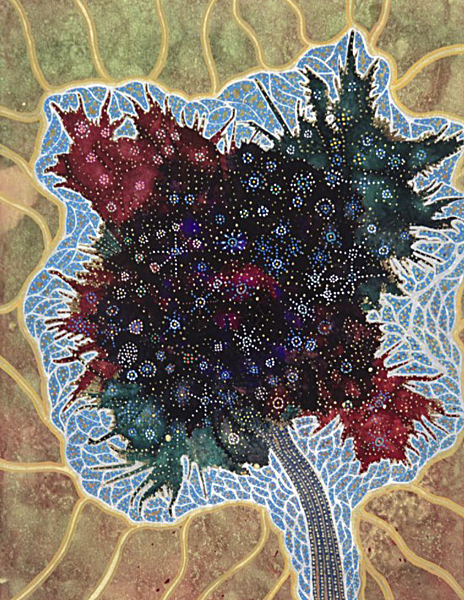
Gallerist Georges Bergès claims he applied for the grants during the Trump years before the gallery represented Hunter. However, it is undeniable that taxpayer-funded Covid relief money now sustains a gallery that promotes and sells the artworks of the president’s son.
This might be disconcerting even to those who think Hunter and Georges Bergès are not involved in unethical behavior. On Oct. 9, 2021, the New York Post reported on the loan question, stating: “While there is no evidence President Biden helped secure the additional $350,000 loan, a watchdog group found that of the more than 100 galleries in New York City’s 10th congressional district, which includes SoHo, TriBeCa and Chelsea, the Georges Berges Gallery received ‘by far’ the largest SBA disaster loan windfall.”
If only a small portion of that “relief” money promoted the Hunter Biden exhibition and sale of his works, someone could be in very hot water over the president’s son directly benefiting from taxpayer-funded loans. Nevertheless, I have no expectations that Attorney General Merrick Garland and the entire Biden Department of Justice, including the FBI, will be delving into the matter.
In the unregulated art industry, you can sell anything to anyone at any price; it is a backdrop for corruption and money laundering. The humming sound coming from the drones is for gaudy and graceless contemporary art—an investment vehicle and method for moving hugh amounts of currency around. If you think the art press would be interested in such a story, think again.
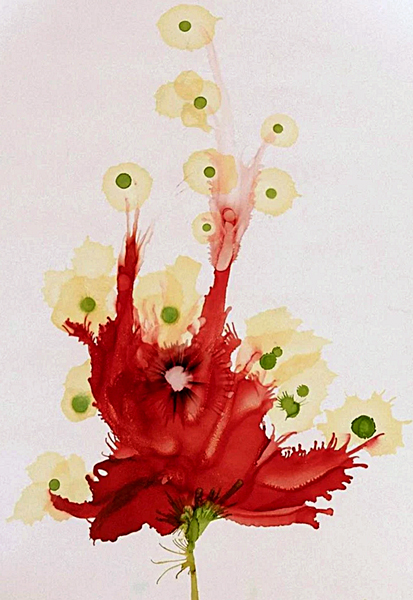
As I see it, contemporary art has been stripped of technical skill and narrative power. Craft has been tossed out the window. Beauty and truth are mirages, nothing more than cultural and political constructs to be avoided.
Consider the successful artists of today. Jeff Koons creates giant balloon animals out of polished stainless steel. His net worth is $500 million. Marina Abramović sat in motionless silence for 2 months at a table during her The Artist Is Present performance at New York’s MOMA. Her net worth is $10 million. Damien Hirst is best know for The Physical Impossibility of Death in the Mind of Someone Living, a 14-foot-long dead shark in an aquarium filled with formaldehyde. His net worth is $1 Billion.
The aesthetics of Koons, Abramović, and Hirst are the norm, and so the fatuous work of Hunter fits right in. Welcome to the art world, circa 2021.
More than a few critics of Hunter’s art have said his works do not convey excellence like those of a virtuoso artist. True but imprecise. Likewise, those who look at Hunter’s paintings and say, “My kid could do that,” are unaware of the actual state of the art world. Contemporary postmodern art practice asserts painting cannot be done on its own, it should be “in conversation” with video, performance, installation, and conceptual art—this is referred to as “pluralism” in art. In that purview painting is a “residual form” of art, meaning, it is from the past and should not be allowed to dominate.
Hunter Biden has said painting “is literally keeping me sane.” It is good to hear he uses art to center himself. With his history of cocaine and crack abuse, and a reckless addiction to prostitutes, he is indeed a troubled man. His art is a form of self-treatment, but he should contact a bonified art therapist for help. We should all be grateful that Art Therapy, a practice rooted in the field of Psychology, brings real healing to distressed individuals. Be that as it may, let us not confuse Hunter’s self-therapy as a contribution to the history of art.
I have been a working artist in Los Angeles most of my life, and deeply involved in the city’s art community. In past decades I have seen LA as a seedbed for creativity and a fountainhead of greatness. I can trace the excellence and distinction of art in Los Angeles going back to the 1900s, when LA artists began to make unique contributions to Modernism and Impressionism.
In 1912 Los Angeles was a center for Synchromism, America’s first foray into abstraction—the movement blended fiery Fauvist color with Cubist and Futurist energy. We had our own “Group of Eight” painters to match Robert Henri and The Eight in New York. The Art Students League, Otis Art Institute, and Chouinard School of Art were top-notch art schools that advanced new directions while teaching basic traditions and methods of painting and draftsmanship. In the 1930s California artists contributed heavily to the American Scene Painting movement; paintings that focused on the land, its people, and the social realities of the time. Closely aligned to the American Scene painters were the Social Realists, whose forte was social commentary. Los Angeles was ground zero for those two art movements that profoundly influenced me.

What I am so very sad to report is that I no longer see this greatness in Los Angeles. I see Hunter Biden and Millie Brown, I see plagiarists masquerading as artists. I see spray-paint vandalism praised by vaunted art institutions. I see entropy and cynicism instead of fecundity and joyous creation. With the second-rate and mediocre being continuously rewarded, it appears that greatness rented a U-Haul to flee the once great City of the Angels—not to mention the rest of the world. But where exactly did greatness go?
For many, being an artist is not a lucrative career, it is a hand to mouth existence. Still, the profession has its rewards, riches that are intangible and etherial. Creating and offering gifts of beauty to humanity is no small affair; some have tried to make it a business, but it has always been a spiritual calling. One creates, not for money or celebrity, but because it needs to be done. I have known ingenious artists blessed with Promethean talent, who made and shared sublime creations. Yet, they passed away unnoticed by the gatekeepers of culture, a fiefdom that assures you will only know the likes of “artists” like Hunter Biden.
The 19th century American painter John Sloan perhaps said it best: “Art enriches life. It makes life worth living. But to make a living at it—that idea is incompatible with making art.” The way I see it, if someone is baffled by Sloan’s thoughtful reflection then they have no real understanding of art.
The words of art critic Robert Hughes (1938-2012) continue to ring in my head. The following statement from Hughes came from his 2008 documentary on contemporary art, The Mona Lisa Curse. It perhaps best sums up the spectacle of Hunter Biden’s entry into the art world, and so it makes the perfect closing to my uncharitable essay:
“The entanglement of big money with art has become a curse on how art is made, controlled, and above all, in the way that it’s experienced. And this curse has affected the entire art world. Apart from drugs, art is the biggest unregulated market in the world, with contemporary art sales estimated at around $18 billion a year. Boosted by regiments of nouveau riche collectors, and serviced by a growing army of advisors, dealers and auctioneers. As Andy Warhol once observed, ‘Good business is the best art.’”



